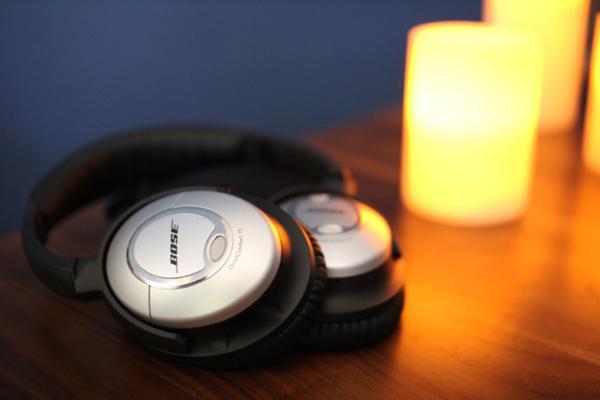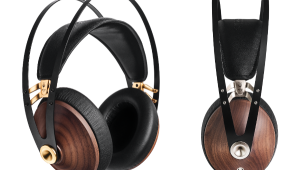Review: Bose QuietComfort 15 Noise Canceling Headphone

This is an article I never thought I’d write. I sold hi-fi (well, Circuit City’s version of “hi-fi”) within sight of The Mountain. I developed early an audiophile’s distain for the four-letter marketing juggernaut. When I began reviewing audio, I couldn’t imagine a situation where I’d review a Bose product. Certainly not something like the market-leading QuietComfort 15 noise-canceling headphone, Not without heavy doses of irony, snark, and derision.
And yet, it is my fiduciary duty to give credit where credit is due.
So behold — not only my first review of a Bose product, but a positive one at that.
In the noise canceling headphone space, Bose owns a 132% market share (check my math). We review a lot of headphones here at S+V, and of late more than a few noise canceling headphones have passed through the Tech^2 column. The QC15s aren’t new, but we’d be remiss in not giving them a fair shake.
We should talk briefly about noise canceling in general. There are lots of models on the market, and the idea is great. In addition to the normal sound muffling possible with most headphones (especially in-ear and over-ear models), some fancy electronics in noise canceling models listen to the world around you, then inject your earholes with magical anti-sound that makes the bad noise go away.
Except, it’s not really magic. Sound is waves, kinda like the ocean. If a peak is headed towards your ear, and the headphone inserts a trough, these two cancel each other out. With simple sine waves, in theory, you’d hear nothing. How well a headphone does this is one of the key differentiators between noise canceling headphones. On one end, you’ll have a significant reduction in ambient noise. On the other end, next to nothing. In the worst case, you can have extraneous noise or adverse effects in any music you’re listening to.
So in addition to all the regular headphone bits, noise canceling models need a microphone, enough processing oomph to rapidly determine the out of phase waveform, and an amplifier to supply said out of phase waveform, and a battery to power said amplifier. In our experience, reviewing many of these models, you can do this cheaply, or good, but not likely both at the same time.
Which brings us to the QC15s. They’re good. Really good. Stupefyingly good. Compared to the other noise canceling models we’ve tested, they are significantly better than all of them. The Bose engineers, over many generations of product, have seriously nailed the noise canceling. Using Brent’s Airplane Sound Simulator (B.A.S.S., TM), the QC15s reduced the roar to the distant background. The better noise canceling headphones reduce the sound, of course, but none as effectively as the QC15s.
In another example, my desk is next my air conditioner (unavoidable, sadly). With the QC15s turned on, I still hear the air coming out of the vents (a woosh, if you will), but all, seriously all, of the mechanical noise of the compressor had disappeared. I kept having to lift an ear cup to make sure it was still engaged.
Compared to the otherwise pretty-good — and $50 more expensive — Audio-Technica ATH-ANC9, the QC15s were 19dB quieter at 400 Hz and 26 dB quieter at 40 Hz. On average, the difference between them was less severe, but the QC15 consistently reduced more noise (check out Brent’s measurements for more specifics).
The other thing the engineers nailed is the comfort. The QC15s are light, with great cushiony earpads. They just barely fit over Brent’s larger ears, something that isn’t true about the highly similar Audio-Technicas.
Sound quality-wise, though, the QC15s lag behind. They’re not bad by any stretch, but they’re not as good as other options. I did my testing using an iPod touch, as I expect it or its iBrethren will be what most people use with the QC15s. Also, given that they’re self-amplified, a headphone amp seemed redundant.
I started my listening tests with “Galway Girl” from Steve Earle’s Trancendental Blues. The QC15s were a little bass heavy, which I normally like, but they’re sloppy. More of a “flumph” than a “thump” to the bass and drums on this track. The acoustic guitar and snare drum were a little forward as well.
Keeping with the word/blues theme, I moved on to the title track from Helplessness Blues by the Fleet Foxes. This many-layered, reverb-laden, mostly acoustic track had lots of upper-midrange, a touch too much for my tastes honestly, but at the same time, the QC15s didn’t sound very open. There’s treble, but not a lot of really high frequencies that add the atmosphere to a track.
I switched over to something more gutsy: “Heartbreaker” from Led Zeppelin’s BBC Sessions. Here the QC15s were much more in their natural habitat, with John Paul Jones pounding away in the low end, Page going nutso, Bonham being Bonham, and Plant somehow keeping above it all.
Listening to the QC15s isn’t unpleasant, in fact I’m sure it was tested extensively for a “pleasant” sound: a little extra bass, not too much treble. It’s like the whole thing’s had an edge taken off, like an old cassette. That’s fine, but more accurate bass and a little better treble would be equally pleasant and less sloppy. I doubt anyone would return them because the sound quality was “bad,” but there are other options that sound better.
In an amusing —to me — twist (it’s usually he who interviews me about headphone opinions), I got Brent’s take on the QC15s compared to his recently reviewed Audio-Technica ATH-ANC9s. He felt the similarities between the two were far greater than the differences. He felt their overall total balance was good, but they were both a little heavy in the bass. He felt the Bose was a little smoother in the midrange, probably in the treble too, but the A-Ts sounded a little more lively. If he had to sum them up, the Bose was a little more refined, the A-Ts a little more exciting, but it’s a subtle difference and he didn’t think he’d be able to predict which one someone would like better. However, he felt the PSBs blew both of them away.
Ah yes, the PSB M4U 2 headphones, which Brent described thus: “Not only does the M4U 2 sound like a really great speaker, it sounds like a great speaker in a great listening room.” Lauren Dragan, who participated in the roundup that featured the PSBs, actually bought a pair for herself. We’re a pretty jaded lot, so for a reviewer to spend their own money on something says a lot. That said, the PSBs are $100 more expensive, and their noise canceling isn’t as good (though, nothing is as good as the Bose on that front).
Aside from the sound, there are a few other small issues. Corporate hubris — like what you’d find with Apple or Sony — is one. The cable connecting the QC15s with your iPod is proprietary. At the headset end there’s a Hi/Lo switch to reduce the volume on overly loud airplane audio systems. There’s no reason for this switch to be on the cable, other than if you lose it, they can charge $15 for a replacement ($30 for the version with the microphone). I suppose there’s a way to get a regular headphone cable deep enough into the ear cup, with a pair of tweezers or something, to negate this complaint. I couldn’t do it with my fingers.
Without music going (and perhaps with as well, though it’s less apparent) there was a mild pressure on the eardrums, something found with many noise-canceling headphones. As I did most of my listening with either no background noise, or with just air con/fan noise, I can’t say if this would be annoying in a louder environment. My guess would be no, or at least it would be less noticeable.
Lastly, the headphones don’t work at all if the battery is dead. This isn’t Bose-exclusive ridiculousness. Some noise canceling headphones are like this, some aren’t. The PSBs, for one, have a passive mode so you can still listen when their battery dies. This seems like such a basic consumer-friendly feature, I don’t understand why all noise canceling headphones don’t work that way. I’ve been on some long plane rides, and it’s not you can pop out to pick a pack of AAA batteries mid-flight. Trust me, I’ve tried. You get looks.
Bottom Line
I guess it comes down to this: If you’re just in the market for headphones and you think you’d occasionally use the noise canceling, get something else. The sound quality from the PSBs is incredible, and much better than the Bose. The noise reduction isn’t as good, but it’s still decent. However, if you’re buying noise canceling headphones specifically for the noise canceling, the Bose QC15s are the absolute choice.
I can’t believe I just wrote that. What’s next? A loving ode to Bose’s $350 clock radio? A sonnet to their 2.5-inch paper-“tweeter” cubes? I don’t know? I just don’t know anymore. Up is down. Left is right. Dogs and cats, living together... it’s mass hysteria.
Measurements
To measure the QC15, I used a G.R.A.S. 43AG ear/cheek simulator, a Clio FW audio analyzer, a laptop computer running TrueRTA analysis software with an M-Audio MobilePre USB audio interface, and a Musical Fidelity V-Can headphone amplifier. I experimented with slight differences in position of the earpieces to get the best seal of the headphone on the cheek plate and the most representative frequency response curves.
The frequency response measurements for the QC15 is typical of that of a neutral-sounding headphone, with bass response rising to a peak at 70 to 80 Hz, and treble response rising between 2 and 3 kHz and in additional peaks at 4 and 6 kHz. Adding 70 ohms output impedance to the V-Can’s 5-ohm output impedance to simulate the effects of using a typical low-quality headphone amp decreases treble response by -1 to -2 dB above 2 kHz. This is an unusual result for a noise-canceling headphone; usually, because they’re internally amplified, they are well-buffered from the effects of source impedance.
Total harmonic distortion (THD) at 100 dBA is unusual. It’s surprisingly low in the bass, at just 1% at 20 Hz, but it rises quite a bit between 2 and 4 kHz, culminating in a peak of about 15% THD at 3.2 kHz. I’ve never seen behavior like this before. However, the problem wasn’t apparent in our tests. Impedance drops from more than 10 kilohms in the bass to a low of 130 ohms at 20 kHz—probably the cause of the slight decrease in treble response with a high-impedance source.
Isolation is by far the best I have measured from an over-ear or on-ear headphone. Compared to the Audio-Technica ATH-ANC9 (which has very good noise reduction), the QC15 achieves an additional -7 to -25 dB of isolation at frequencies below 1 kHz. It’s especially impressive at frequencies below 100 Hz, where most noise-canceling headphones tend to achieve only a decibel or two of isolation at best.
Average sensitivity with a 1 mW signal at 32 ohms impedance is 96.9 dB from 300 Hz to 10 kHz, 98.7 dB from 300 Hz to 6 kHz. — Brent Butterworth






















































